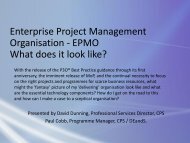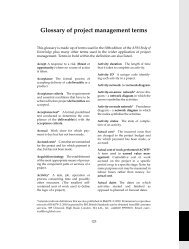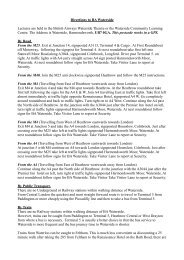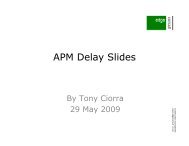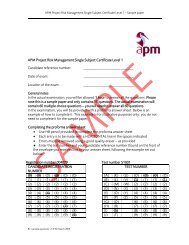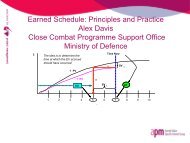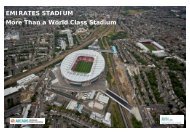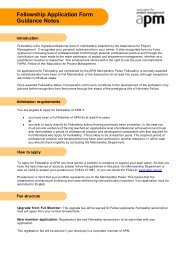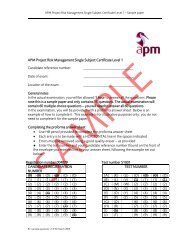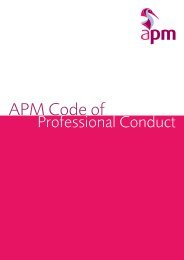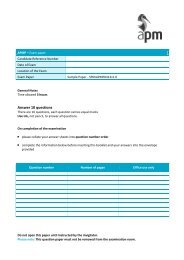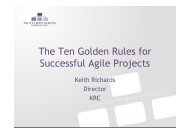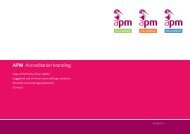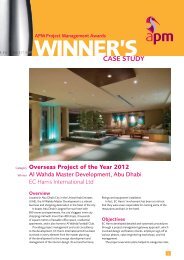Read the full case study here - Association for Project Management
Read the full case study here - Association for Project Management
Read the full case study here - Association for Project Management
You also want an ePaper? Increase the reach of your titles
YUMPU automatically turns print PDFs into web optimized ePapers that Google loves.
APM <strong>Project</strong> <strong>Management</strong> Awards<br />
WINNER’S<br />
CASE STUDY<br />
Interface management<br />
Some of <strong>the</strong> challenges faced included <strong>the</strong> integration and<br />
<strong>the</strong> coordination of <strong>the</strong> many interfaces <strong>for</strong> <strong>the</strong> project<br />
involving multiple stakeholders with conflicting demands.<br />
Coordinating <strong>the</strong> requirements <strong>for</strong> athletes, officials,<br />
VIPs, written press, broadcasters, work<strong>for</strong>ce, sponsors,<br />
spectators, and of course <strong>the</strong> operator, is complex and<br />
requires delicate balance.<br />
Arup’s project management team had <strong>the</strong> challenge of<br />
coordinating 20 specialist Arup engineering disciplines,<br />
ensuring <strong>the</strong>y were properly integrated, and that <strong>the</strong><br />
complex interfaces of <strong>the</strong> Water Cube were properly<br />
understood and documented.<br />
Developing on previous Arup project management<br />
work at London’s Heathrow Terminal 5, <strong>the</strong> project<br />
management team introduced an interface management<br />
strategy which divided component parts of <strong>the</strong> Water<br />
Cube into volumes defined by physical and time<br />
boundaries which were described in a project volume<br />
register and each volume assigned an owner.<br />
An interface occurred when anything touched or<br />
crossed a boundary. Initially all high (key) and low level<br />
interfaces were identified and captured on a register, and<br />
regular interface management and coordination meetings<br />
held involving all parties. The principle began working<br />
very well internally, and was quickly expanded to include<br />
external interfaces w<strong>here</strong> Arup required in<strong>for</strong>mation from<br />
ano<strong>the</strong>r team or third party – e.g. <strong>the</strong> interior designers, or<br />
utility supplies from off site. These external interfaces were<br />
classified as:<br />
Physical – a point or plane common to two or more<br />
parties at which a physical interdependency exists, e.g.<br />
<strong>the</strong> location of an underground service or duct route.<br />
Functional – a relationship between two parties at<br />
which per<strong>for</strong>mance independency exists, eg power<br />
requirements or data connectivity.<br />
Organisational and contractual – a relationship between<br />
two parties in which a delineation in scope or contractual<br />
responsibility exists, e.g. <strong>the</strong> development of details by<br />
Arup’s Chinese design partners CCDI based on Arup’s<br />
scheme designs, or interfaces between civil engineering<br />
and architectural landscaping documentation.<br />
Operational – a relationship between two parties at<br />
which delineation in operational responsibility exists,<br />
e.g. maintenance <strong>for</strong> equipment under warranty with <strong>the</strong><br />
ongoing maintenance and replacement by <strong>the</strong> operator,<br />
and <strong>the</strong> short term responsibilities <strong>for</strong> Olympic overlay<br />
compared to pre-Olympics mode and <strong>the</strong>n legacy mode.<br />
The management of interfaces became one of <strong>the</strong> most<br />
important functions of <strong>the</strong> project management team<br />
during <strong>the</strong> Water Cube design and in <strong>the</strong> longer term,<br />
Arup believes <strong>the</strong> results will also generate significant<br />
savings in construction cost compared to current practice.<br />
Safety in design<br />
Measured by international standards, construction site<br />
safety records in China are poor. At <strong>the</strong> implementation<br />
plan workshop, Arup’s project management team made<br />
a strong commitment to explore <strong>the</strong> risk-prone activities<br />
likely to occur in <strong>the</strong> construction of <strong>the</strong> Water Cube,<br />
and to potentially improve safety by following a ‘Safety in<br />
Design’ approach. This included producing documentation<br />
that would improve safety awareness, suggesting planned<br />
and logical methods <strong>for</strong> construction and maintenance.<br />
Using <strong>the</strong> UK Construction Design and <strong>Management</strong><br />
(CDM) Regulations, and draft NSW legislation, this<br />
approach was intended to ensure that unusual hazards<br />
and risks (such as post-Olympic alterations to <strong>the</strong> internal<br />
fit-out, and working-at-height hazards involved in<br />
maintenance of light fittings or adjusting broadcasting<br />
equipment) were eliminated or controlled at <strong>the</strong> design<br />
stage w<strong>here</strong>ver possible.<br />
The final hazard risk register was included with tender<br />
documentation along with recommendations that it be<br />
incorporated into <strong>the</strong> safety management plans <strong>for</strong> <strong>the</strong><br />
various package contractors on site.<br />
The people factor<br />
To remove potential pinch points from specific key staff<br />
becoming overloaded, and to allow technical staff more<br />
freedom, Arup’s project managers established<br />
semi-independent teams with <strong>the</strong>ir own leadership,<br />
to progress in parallel streams.<br />
The four teams included design, product research,<br />
stakeholder engagement and commercial issues such as<br />
scope, contract and fees. For example, Arup established<br />
clean interfaces that would allow <strong>the</strong> finalisation of <strong>the</strong><br />
structural geometry and research into <strong>the</strong> ETFE facade<br />
per<strong>for</strong>mance to proceed without holding up <strong>the</strong> general<br />
space planning of <strong>the</strong> building. Leadership <strong>for</strong> key<br />
stakeholder meetings was separate from commercial<br />
negotiations, so that one did not compromise <strong>the</strong> o<strong>the</strong>r.<br />
Following <strong>the</strong> success of <strong>the</strong> Water Cube<br />
implementation model, it has now become standard<br />
practice on all of Arup’s major projects. Having specialist<br />
project managers providing leadership, while still providing<br />
freedom to technical staff, significantly improved <strong>the</strong><br />
design process and embedding project management into<br />
<strong>the</strong> business was more easily accepted as <strong>the</strong> specialist<br />
project managers on <strong>the</strong> Water Cube also had technical<br />
engineering backgrounds. In this way <strong>the</strong> specialist project<br />
managers were able to contribute at all levels, ra<strong>the</strong>r than<br />
ever being perceived as a ‘non-technical’ overhead.<br />
Developing <strong>the</strong> tools to deliver<br />
The Water Cube was a catalyst <strong>for</strong> <strong>the</strong> development of<br />
a range of bespoke project management planning and<br />
monitoring tools. Such tools were needed to deliver such<br />
5



